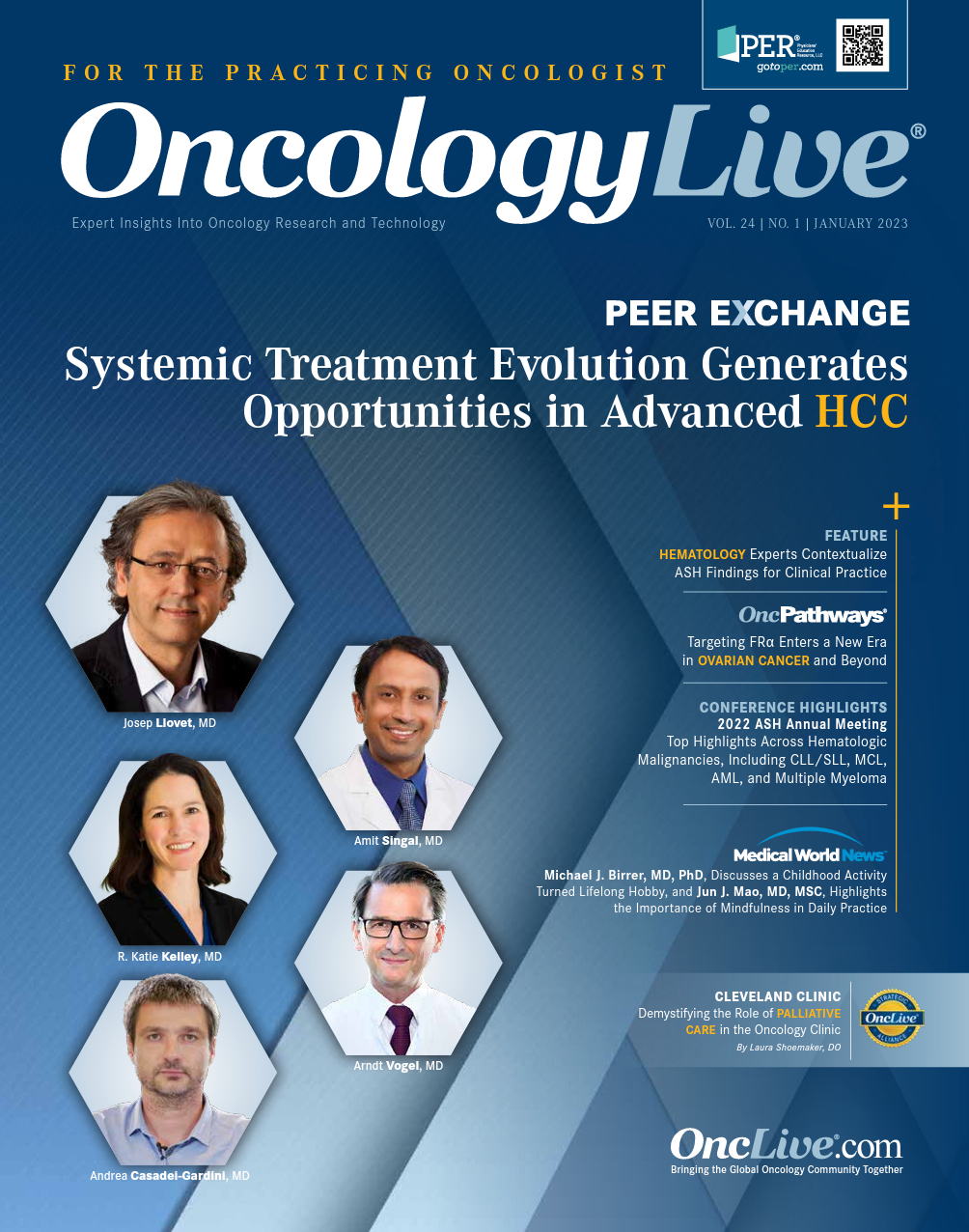Publication
Article
Experts Contextualize ASH Findings for Clinical Practice
Author(s):
Data presented during the 2022 ASH Annual Meeting and Exposition showcased practice-changing updates from several studies across hematologic malignancies. Experts across hematologic cancers were on hand to discuss long-term readouts, the introduction of novel regimens for several diseases, and the impact of new data and trends in care for patients.
Marc J. Braunstein, MD, PhD

Data presented during the 2022 American Society of Hematology Annual Meeting and Exposition showcased practice-changing updates from several studies across hematologic malignancies. Experts across hematologic cancers were on hand to discuss long-term readouts, the introduction of novel regimens for several diseases, and the impact of new data and trends in care for patients.
In a series of interviews with OncLive®, hematologist/ oncologists unpacked how the treatment landscape in the coming year may shift based on these findings.
Marc J. Braunstein, MD, PhD, assistant professor in the Department of Medicine and course codirector of Hematology and Oncology System at NYU Long Island School of Medicine in New York
OncLive®: The phase 3 IFM2017_03 trial (NCT03993912) compared lenalidomide (Revlimid) and subcutaneous daratumumab (Darzalex Faspro) plus 2 cycles of dexamethasone vs lenalidomide and dexamethasone in frail patients with previously untreated multiple myeloma ineligible for high-dose therapy. Frailty was defined as ECOG proxy frailty score of at least 2.1 Do you believe dexamethasone can be safely omitted from treatment in this population?
Braunstein: We know that frail patients with multiple myeloma are more prone to adverse effects [AEs] of treatment, particularly from corticosteroids such as dexamethasone. As background, there was a randomized phase 3 study published last year in Blood that compared continuous lenalidomide/dexamethasone vs dropping the dexamethasone after approximately 9 cycles in 200 intermediate-fit patients with newly diagnosed myeloma.2 That study found that there was longer event-free survival [EFS] and no difference in progression-free survival [PFS] with dexamethasone discontinuation and just continuing lenalidomide maintenance.
[IFM2017_03 included] 295 frail newly diagnosed patients with myeloma. What was interesting was that the overall response rates were significantly higher in the daratumumab/lenalidomide group, 89% vs 77% [with lenalidomide/dexamethasone] with shorter time to reach a very good partial remission at only 5 months vs 11 months in the lenalidomide/dexamethasone arm. There was no difference in treatment continuation. These data provide additional evidence that will satisfy both clinicians and patients alike that dexamethasone may be discontinued in the long run for maintenance therapy.
A translational study evaluated bone marrow samples of patients who received treatment with idecabtagene vicleucel (ide-cel; Abecma) in the KarMMa study (NCT03361748).3 These data showed differences in initial samples vs those with acquired resistance samples. How might these data inform treatment sequencing and potential combination strategies?
Great, great study. [chimeric antigen receptor] CAR T cells directed at BCMA have demonstrated unprecedented response rates in heavily pretreated patients with myeloma. In the phase 2 KarMMA study, which looked at ide-cel approximately 27% of patients had no response and more than half of the patients progressed at 12 months. This study was investigating why there are potential differences between responders and nonresponders to ide-cel. It’s correlative study, [investigators] performed molecular profiling of CD38-positive myeloma cells extracted from bone marrow of patients at baseline and on follow-up comparing expression responders and expression patterns rather in responders vs nonresponders to ide-cel.
The interesting findings included that individuals who did not have a sufficient response to CAR T, had increased expression of known myeloma markers, several of which were previously targeted in these patients for treatment, including CD38, SLAM7, BCL2, and FGFR3. So, there may be potential to combine agents targeting those proteins during or after CAR T-cell therapy. In addition, the authors found that BCMA expression was decreased at relapse, and that may have implications for treating with subsequent BCMA-targeted approaches.
Optimal duration of lenalidomide maintenance therapy was addressed in the Myeloma XI trial (NCT01554852).4 How might the results affect lenalidomide administration and discussions around whether to add a proteasome inhibitor?
There’s a lot of interest in the field in terms of maintenance therapy and Myeloma XI is a complex trial comparing 2 different IMiD-based induction regimens followed by either transplant or nontransplant options, both of which include maintenance [lenalidomide] vs observation. Approximately 1248 transplant-eligible patients with myeloma were randomly assigned and [investigators] measures outcomes such as [minimal residual disease] MRD negativity at different times over the course of 1 to 5 years and beyond of maintenance therapy. Not surprisingly, as previously reported, authors noted that lenalidomide maintenance was associated with significant PFS benefits of 64 vs 32 months in this population compared with observation.
This was true across various risk categories in including standard-risk and high-risk cytogenetics and that benefit was retained up to 4 years from the start of maintenance. However, it’s worth noting that standard -risk and highrisk patients were not necessarily compared with one another, but they all benefited from maintenance. Now, the interesting part of this abstract is that the benefit of longer duration lenalidomide maintenance seemed to be greater for patients who are MRD positive at the start of maintenance than in those who were MRD negative at the start of maintenance, with a lower risk of progression at up to 3 years. However, and this is interesting as well, beyond 3 years of maintenance, there’s no statistically significant difference in PFS benefit among these groups. This is another line of evidence that shows that maintenance clearly delays progression in multiple myeloma, whether a patient receives transplant or not. The duration is still a question mark.
In the phase 1/2 CC-92480-MM-001 study (NCT03374085) impressive clinical activity and a manageable safety profile were shown with mezigdomide (CC-92480), a novel CELMoD compound, when combined with dexamethasone in patients with triple-class relapsed or refractory multiple myeloma.5 Do you see this agent being moved up as treatments generally are in oncology or reserved for more heavily pretreated patients based on these data?
Refractoriness to [immunomodulators (IMiDs)] predicts overall treatment resistance and has been shown in various studies to have reduced survival in patients with relapsed or refractory multiple myeloma. Mezigdomide is a CELMoD, which is short for cereblon E3 ligase modulating drug, and this class of agents have great potential to resensitize IMiD refractory patients to treatments targeting downstream oncogenic proteins.
This abstract is a phase 1/2 investigation of mezigdomide plus dexamethasone in patients with multiple myeloma who are heavily pretreated with a median of 6 prior lines of therapy. Importantly, 100% of patients were IMiD exposed, and approximately 30% were previously treated with a novel BCMA targeting agent. The authors found at a median of 6 months, the overall response rate was approximately 40%. And again, these are heavily pretreated patients and there was a median PFS of close to 5 months. Although it’s worth noting that these data are immature, and we need more time for follow-up to assess the responses duration of response.
What was even more interesting was the examination of the cohort of 30 patients with prior anti-BCMA therapy, the overall response rates were as high as 50%, which suggests that progression after BCMA therapy may alter sensitivity to prior targets or novel therapies such as CELMoDs.
With that said, where do you see CELMoDs as a class headed in myeloma?
Like with all therapies in myeloma, we first examine them in the relapsed or refractory setting and then slowly move them into earlier lines. [Should they] be approved [it will be for] triple-class refractory, including IMiD-refractory patients who have been relatively heavily pretreated because it can overcome resistance in that setting. But we may f ind that it has even perhaps the same or better efficacy than lenalidomide/pomalidomide when used in earlier lines of therapy.
For more with Braunstein visit: https://bit.ly/3jijaDM
Harry P. Erba, MD, PhD, clinical investigator in the Division of Hematologic Malignancies and Cellular Therapy in the Department of Medicine, director of the Leukemia Program, and director of Phase I Development in Hematologic Malignancies at Duke Cancer Institute
The triplet of azacitidine (Vidaza) and venetoclax (Venclexta) produced high complete response rates and was well tolerated as first-line therapy in patients with high-risk de novo and secondary acute myeloid leukemia (AML) regardless of TP53 mutation status, according to findings from a phase 1/2 trial (NCT04435691) for an elderly comorbid population with adverse risk features.6 What are your thoughts on where this regimen may land?
Harry P. Erba, MD, PhD

Ebra: Ultimately, we’ll need a phase 3 study to see if there’s a benef it for patients, especially in terms of EFS or, more importantly, OS. The thing that impressed me the most was in newly diagnosed patients there really didn’t seem to be much activity in patients who had prior exposure to venetoclax. When the newly diagnosed patients, especially those with TP53 mutation there was a high response rate.
When they comparison of that triplet with patients treated with azacitidine previously, and performing a propensity matching score for the subpopulation, the median survival was longer in the patients receiving the triplet than just the azacitidine alone. A lot still needs to be done. These patients move on to transplant, we agree with that, but even then, the outcomes following transplant leave much to be desired. And we still have a lot of to do in that patient population.
The phase 3 ASAP trial (NCT02461537) explored whether achieving complete response with intensive chemotherapy is necessary prior to allogeneic transplant.7 What are your thoughts on why we didn’t see improved survival with the more intensive approach? Do you see it affecting how intensive remission induction is thought about in other settings?
An unanswered question in the management of patients with primary refractory acute myeloid leukemia is: Do you take patients straight to transplant or do you give them salvage therapy? And [beyond that] if they get into a remission, does it need to be MRD-negative remission before a specific type of transplant? This study was well designed, accrued many patients. [Investigators] randomly assigned patients to watch and wait but allowed low-dose cytarabine or hydroxyurea if the patient needed for disease control prior to a transplant vs getting a salvage regimen and then going onto the transplant.
What they showed was that there was basically no difference at day 56 following transplant in those 2 arms in terms of CR rates or relapse rates after the transplant or OS. It’s interesting study. In the patients who got salvage chemotherapy, you could see from their cumulative incidence of response that there were some patients who achieved a CR with the salvage regimen before they went on to transplant. One question from the transplant physician’s point of view is, if a patient has refractory disease, do they do better if you get them into a remission first with intensive chemotherapy, or if you don’t get them into a remission with intensive chemotherapy, that’s the comparison.
Another is: Does the response to that salvage regimen really make a difference? I don’t think we have that answer yet. Of course, there are nuances in the types of transplants that were allowed. This was a very specific preparative regimen that was used in this study. I’m not sure if it’s going to change.
For more with Erba visit: https://bit.ly/3jijaDM
Joshua Brody, MD, associate professor of medicine, hematology, and medical oncology, and of oncological sciences at Mount Sinai Hospital
Consolidation therapy with high-dose chemotherapy and autologous stem cell transplantation (HD-ASCT) improved PFS vs nonmyeloablative chemoimmunotherapy in patients with primary central nervous system lymphoma, according to data from the phase 3 MATRix/IELSG43 trial (NCT02531841).8 Could you please share your insight on the trial and what these data may mean?
Joshua Brody, MD

Brody: This one of the most exciting abstracts here at this year’s ASH, in that it will absolutely impact the way we take care of our patients. It’s also exciting because this is [the result of] hard work in primary lymphoma, a tough disease, and especially in putting patients on trials, [as] these trials take time to get patients enrolled and sometimes these patients cannot wait around. I say, [these data are] be practice changing because the punchline is this randomized phase 3 trial in a space, the last one I remember was more than 10 years ago and was not as impactful as this one will be.
The punchline result is that patients had a marked improvement in both PFS and OS at 3 years with a more dose-intensive approach that they used here. Randomization was that everyone got a frontline induction chemotherapy, and they were randomized afterwards to receive just moderate, chemotherapy consolidation vs myeloblative chemotherapy, followed by autologous stem cell transplant. The myeloblative consolidation group had a marked improvement [3-year PFS 79% vs 53%; HR, 0.42; P =.0003].
It’s not for every patient, it’s for the younger healthier patients and in this study, investigators only looked at individuals aged 65 years and younger, but still we have not had this kind of a benefit seen for primary lymphoma any time recently since the advent of the most basic therapies we have. This is a big, big deal and a well-warranted [late-breaking abstract] LBA.
For more with Brody visit: https://bit.ly/3jmu0bT
Aaron Gerds, MD, associate professor in medicine (hematology and medical oncology) at Cleveland Clinic Taussig Cancer Institute
Momelotinib elicited durable symptom, transfusion independence, and splenic responses through 48 weeks of treatment in patients with myelofibrosis who have anemia and previously received a JAK inhibitor, according to findings from the phase 3 MOMENTUM trial (NCT04173494).9 As the lead study author, could you please provide a little bit of background and then go into the updated findings?
Aaron T. Gerds, MD, MS

Gerds: Momelotinib is a JAK1/JAK2 inhibitor that also inhibits ACVR1, so it comes with the promise of treating both spleen volumes as well as symptom burdens and anemia all at the same time in 1 package. This is a very attractive treatment option because many patients at the time of diagnosis will also have anemia in addition to symptoms and increased spleen size. But most certainly over the course of illness, every patient will develop anemia if their disease course is long enough. This is such a critical and unmet need in the field.
MOMENTUM was trying to leverage that anemia effect to a large degree, and it pitted momelotinib vs danazol in patients who had previously had a JAK inhibitor who were also anemic and had significant symptom burden. At primary analysis, the [previously presented] week 24 data showed that momelotinib was superior to danazol in improving symptoms and spleen size and was not inferior to danazol for transfusion independence. That was a blinded portion of the study where we didn’t know which treatment these patients were getting. At week 24, patients were allowed to cross over to open-label arm. I presented updated data through week 48 and really this was the first time we described those results and we found that patients continued to have significant symptom and spleen improvements and maintain transfusion independence.
Results of a study evaluating the combination of selinexor (Xpovio) with ruxolitinib (Jakafi) in treatment-naïve myelofibrosis were presented at the meeting. What are the most important takeaways you think from that study?
Combination therapies are the next big wave in myelofibrosis and [myeloproliferative neoplasms] MPNs in general. We have JAK inhibitors and now we’re going to combine them with new therapies attacking different pathways that all lead to a positive downstream effect. Selinexor is at a good candidate because of the nonoverlapping toxicity profiles with ruxolitinib and the very different mechanism action. This abstract is intriguing. The response rates were incredibly high, I would argue higher than expected. But the numbers were quite small. It’s an early peek at a really interesting therapy with some potential.
For more with Gerds visit: https://bit.ly/3joGCzi
Catherine C. Coombs, MD, associate professor in the Division of Hematology Oncology in the Department of Medicine at University of California Irvine School of Medicine
Treatment with zanubrutinib (Brukinsa) reduced the risk of progression or death by 35% compared with ibrutinib (Imbruvica) for patients with relapsed or refractory chronic lymphocytic leukemia (CLL) or small lymphocytic lymphoma (SLL), according to findings from the phase 3 ALPINE study (NCT03734016).10 What is most exciting about this study?
Catherine C. Coombs, MD

Coombs: We saw that there’s a superior PFS for zanubrutinib as compared to ibrutinib. But one of the curious aspects of the data is that the ibrutinib arm actually didn’t perform quite as well to what I think most of us would’ve expected based on what’s been seen in the RESONATE trial [NCT01578707], the ELEVATE-RR trial (NCT02477696). The data that I’ve seen looks good.
With respect to the head-to-head toxicity [comparison] so far as zanubrutinib looks very well tolerated, especially in comparison to ibrutinib with lower rates of atrial fibrillation and flutter.
For more with Coombs visit: https://bit.ly/3joGCzi
References
- Mainer S, Coore J, Hullin C, et al. A dexamethasone sparing-regimen with daratumumab and lenalidomide in frail patients with newly-diagnosed multiple myeloma: efficacy and safety analysis of the phase 3 IFM2017-03 trial. Blood. 2022;140(suppl 1):1369-1370. doi:10.1182/blood-2022-159933
- Larocca A, Bonello F, Gaidano G, et al. Dose/schedule-adjusted Rd-R vs continuous Rd for elderly, intermediate-fit patients with newly diagnosed multiple myeloma. Blood. 2021;137(22):30273036. doi:10.1182/blood.2020009507
- Samur MK, Martin N, Thompson E, et al. Differences in single cells between BCMA-Targeting CAR T-cell therapy responders and non-responders reveals initial resistance and acquired resistance are driven by different factors. Blood. 2022;140(suppl 1):2106-2107. doi:10.1182/blood-2022-168903
- Pawlyn C, Menzies T, Davies FE, et al. Defining the optimal duration of lenalidomide maintenance after autologous stem cell transplant - data from the Myeloma XI trial. Blood. 2022;140(suppl 1):1371-1372. doi:10.1182/ blood-2022-165376
- Richardson PG, Trudel S, Quach H, et al. Mezigdomide (CC92480), a potent, novel cereblon E3 ligase modulator (CELMoD), combined with dexamethasone (DEX) in patients (pts) with relapsed/refractory multiple myeloma (RRMM): preliminary results from the dose-expansion phase of the CC-92480-MM-001 trial. Blood. 2022;140(suppl 1):1366-1368. doi:10.1182/ blood-2022-157945
- Daver N, Senapati J, Maiti A, et al. Phase I/II study of azacitidine (AZA) with venetoclax (VEN) and magrolimab (Magro) in patients (pts) with newly diagnosed (ND) older/unfit or high-risk acute myeloid leukemia (AML) and relapsed/refractory (R/R) AML. Blood. 2022;140(suppl 1):141-142. doi:10.1182/ blood-2022-170188
- Stelljes M, Middeke JM, Bug G, et al. In patients with relapsed/ refractory AML sequential conditioning and immediate allogeneic stem cell transplantation (allo-HCT) results in similar overall and leukemia-free survival compared to intensive remission induction chemotherapy followed by allo-HCT: results from the randomized phase III ASAP trial. Blood. 2022;140(suppl 1):9-11. doi:10.1182/blood-2022-159962
- Illerhaus G, Ferreri AJM, Binder M, et al. Effects on survival of non-myeloablative chemoimmunotherapy compared to highdose chemotherapy followed by autologous stem cell transplantation (HDC-ASCT) as consolidation therapy in patients with primary CNS lymphoma - results of an international randomized phase III trial (MATRix/IELSG43). Blood. 2022;140(suppl 2):LBA-3. doi:10.1182/blood-2022-171733
- Gerds AT, Mesa R, Vannucchi AM, et al. Updated results from the momentum phase 3 study of momelotinib (MMB) versus danazol (DAN) in symptomatic and anemic myelofibrosis (MF) patients previously treated with a JAK inhibitor. Blood. 2022;140(suppl 1):1514-1515. doi:10.1182/blood-2022-162783
- Brown JR, Eichhorst B, Hillmen P, et al. Zanubrutinib demonstrates superior progression-free survival (PFS) compared with ibrutinib for treatment of relapsed/refractory chronic lymphocytic leukemia and small lymphocytic lymphoma (R/R CLL/SLL): results from final analysis of ALPINE randomized phase 3 study. Blood. 2022;140(suppl 2):LBA-6. doi:10.1182/ blood-2022-171538









